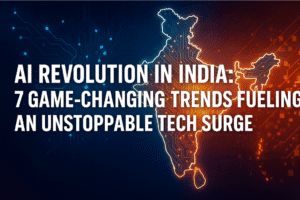AI Revolution in India: 7 Game-Changing Trends Fueling an Unstoppable Tech Surge
Indian businesses are prioritizing Small Language Models (SLMs) over bulky alternatives, favoring cost-effective, localized solutions for sectors like healthcare, retail, and agriculture. This shift aligns with sustainability goals while addressing regional needs through faster, tailored AI applications. Concurrently, advanced hardware—specialized chips and hybrid computing architectures—is reclaiming prominence, powering AI efficiency and supporting India’s semiconductor self-reliance ambitions.
Innovations in context-aware intelligence are transforming industries: spatial computing enables proactive decision-making in defense simulations, while healthcare leverages AI for precision diagnostics and training. However, legacy system modernization demands significant investment, and quantum computing’s looming encryption risks urge adoption of quantum-safe security. Workforce upskilling and ethical AI frameworks remain critical as businesses balance automation with human collaboration.
To sustain momentum, India must bolster infrastructure, foster public-private R&D partnerships, and position itself as a global hub for ethical, scalable AI solutions—turning localized innovation into a blueprint for inclusive growth.

AI Revolution in India: 7 Game-Changing Trends Fueling an Unstoppable Tech Surge
As India accelerates its journey toward becoming a global tech powerhouse, businesses are pivoting to embrace Small Language Models (SLMs) and multimodal AI systems to deliver faster, context-aware solutions. Deloitte’s latest report reveals a strategic shift in how Indian enterprises leverage AI—not as a standalone tool but as the backbone of innovation across industries. Here’s a deep dive into the trends shaping this transformation and what they mean for India’s future.
- The Rise of Small Language Models (SLMs): Precision Over Size
While global attention often focuses on large language models (LLMs) like GPT-4, Indian businesses are betting on smaller, specialized models to address localized challenges. SLMs, trained on niche datasets, offer distinct advantages:
- Efficiency: Lower computational costs and energy use, critical for India’s sustainability goals.
- Speed: Real-time processing for applications like regional language chatbots or agriculture analytics.
- Targeted Solutions: Customizable for sectors like healthcare (diagnostics), retail (hyper-personalized recommendations), and finance (fraud detection).
Why it matters: In a diverse market like India, SLMs bridge the gap between generic AI tools and region-specific needs, enabling scalable solutions without massive infrastructure investments.
- Hardware’s Comeback: Fueling the AI Engine
The generative AI boom has reignited interest in advanced hardware. Indian tech leaders are reimagining infrastructure to support AI-driven demands:
- Specialized Chips: Designed for power management, telecom, and cryptography, these chips optimize performance for critical applications.
- Heterogeneous Computing: Combining GPUs and NPUs on a single chip boosts efficiency for AI workloads, from weather modeling to supply chain optimization.
The big picture: India’s push for semiconductor self-reliance aligns with this trend, positioning the country to reduce dependency on imports while fostering innovation in AI hardware.
- Context-Aware Intelligence: Beyond Automation
AI is evolving from reactive systems to proactive, intent-driven tools. By integrating spatial computing, IoT sensors, and predictive analytics, businesses are unlocking:
- Hyper-Personalization: Retailers use customer behavior data to predict purchasing trends.
- Smart Resource Allocation: Farmers leverage soil health and weather data for precision agriculture.
- Adaptive Learning: Edtech platforms tailor content to individual student needs.
Abhrajit Ray of Deloitte India notes, “This shift isn’t just about efficiency—it’s about creating systems that anticipate needs, making technology more inclusive and future-ready.”
- Spatial Computing in Action: Defense and Healthcare Lead
- Defense: AI-powered mixed reality simulations enhance strategic training and mission preparedness.
- Healthcare: Surgeons use VR environments for risk-free training, while AI improves diagnostic accuracy through 3D imaging analysis.
The challenge: Scaling these technologies requires robust 5G networks and affordable AR/VR devices—areas where India still faces gaps.
- AI-Driven Core Modernization: Breaking Legacy Chains
Enterprises are replacing rigid, monolithic systems with modular, AI-integrated architectures. Benefits include:
- Agility: Faster adaptation to market shifts (e.g., dynamic pricing in e-commerce).
- Cost Efficiency: Automating workflows in manufacturing and logistics.
- Compliance: AI monitors regulatory changes in real time for sectors like banking.
But hurdles remain: Legacy system overhauls demand significant investment, and cybersecurity risks grow as AI permeates critical infrastructure.
- Quantum Computing Risks: Securing India’s Digital Future
The looming “Year to Quantum” (Y2Q) threat—where quantum computers could crack traditional encryption—has urgent implications. Deloitte emphasizes adopting:
- Quantum-Safe Encryption: To protect financial, defense, and public sector data.
- AI-Enhanced Security: Proactive threat detection using machine learning.
- Upskilling India’s Workforce: The Human-AI Partnership
AI isn’t replacing talent—it’s amplifying it. Developers use AI for code generation, reducing manual effort by up to 40% (as per industry estimates). However, success hinges on:
- Reskilling Programs: Bridging the gap in AI literacy.
- Ethical Frameworks: Ensuring transparency and fairness in automated decisions.
The Road Ahead: Challenges and Opportunities
While India’s AI momentum is undeniable, Deloitte identifies critical focus areas:
- Infrastructure: Scaling high-performance computing and renewable energy to support AI growth.
- Collaboration: Partnerships between startups, academia, and government to drive R&D.
- Global Leadership: Positioning India as a hub for ethical, affordable AI solutions.
Final Takeaway
India’s AI journey is no longer about catching up—it’s about leading with innovation tailored to its unique challenges. By prioritizing SLMs, smarter hardware, and ethical frameworks, businesses can turn these trends into actionable strategies, driving inclusive growth and securing a competitive edge in the global arena.
You must be logged in to post a comment.